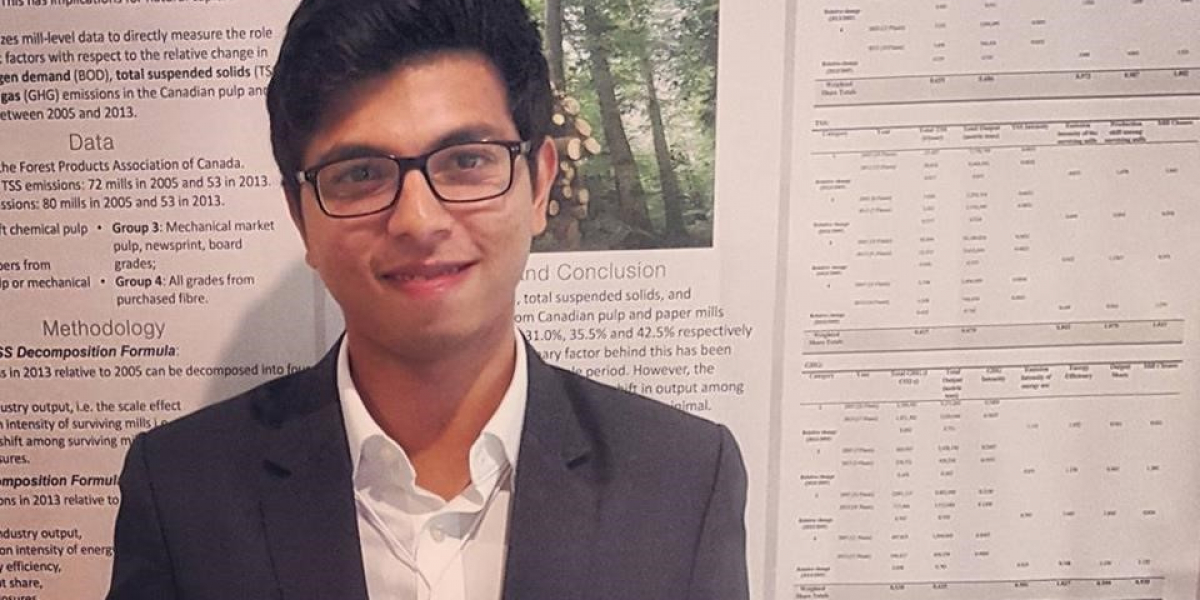
Guest post by Mishaal Sinha
The Natural Capital Symposium is an annual event hosted by the Natural Capital Project (NatCap) at Stanford University that brings together dynamic and inspiring scholars, professionals and experts on natural capital from all around the world. Many of those featured in the event are considered to be celebrities in this field—Hal Mooney (world renowned ecologist at Stanford), Stephen Polasky (from the University of Minnesota) and Mark Tercek (president of the Nature Conservancy), to name a few. And so naturally, it was an enormous privilege to have the opportunity to present my research work on pollution emissions in the Canadian pulp and paper sector at the event this year.
The four-day event, which took place from March 21-24, was an incredibly insightful and exciting opportunity to learn, exchange ideas, and collaborate with both experts and peers, in an open and approachable environment. The managing director of NatCap, Mary Ruckelshaus, began the event by asking all of the participants to introduce themselves. And as the microphone made its way around the hall, one-by-one — to nearly three hundred attendees from around thirty countries— it became apparent how diverse the expertise and perspectives of those convened really was. Yet, there was a common aspiration shared by everyone: to help change the way we value nature, and to appropriately incorporate ecosystem services into mainstream policy and decision-making. By providing a platform to share success stories and lessons learned regarding natural capital and sustainability approaches from all over the world, the symposium stimulates new ways of problem solving, cooperation, and pushing for meaningful change to improve the well-being of people and nature.
The event was organized across three simultaneous tracks, and attendees could pick-and-choose whichever sessions they were most interested in. The “Pathways to Impact” track featured speakers (such as Lynn Scarlett from The Nature Conservatory, and Jonathan Kochmer from Earth Economics, among a number of others) and held plenary sessions that highlighted projects where ecosystem services information was used to inform decisions and outcomes. The presentations concluded with Q&A sessions, which were as informative as the presentations themselves. This was also the track where I spent most of my time, particularly because it featured topics that were closely related to my areas of interest—and to the projects SP is involved in. One such example would be the presentation by Kend Bagstad from WAVES (Wealth Accounting and Valuation of Ecosystem Services), The World Bank, on the topic of natural capital accounting. (SP’s report on ‘Linking Natural Capital and Productivity” was recently published on the organization’s website).
The “Training” track was a 3-day course where attendees could learn about NatCap’s primary open-source tool, InVEST, in hands-on sessions with trainers. The sessions begin with introductory seminars focusing on the basics, and by the third day progressed to hands-on exercises using the software.
Finally, the “Learning Exchange” featured theoretical and experimental work that’s still in the development stage but has potential to make an impact. This track was comprised of 8 sessions that included lightning talks (5 minute presentations made in succession, with a Q&A session at the end); roundtable discussions; and poster presentations—where my research on pollution emissions in the Canadian pulp and paper sector was presented as one of 37 poster presentations.
The poster sessions included academic and practical research on a broad spectrum of topics related to Natural Capital and Ecosystem services. These ranged from valuating fisheries in Southeast Alaska; to analyzing the role of deadwood for biodiversity and ecosystem services; to my own research pertaining to pollution emissions in the pulp and paper industry.
My research paper involved examining specific economic factors that led to the relative change in emissions of certain pollutants (including greenhouse gases) in the Canadian pulp and paper industry. My results indicate that although pollution emissions fell in the time period I considered, the major factors contributing to the decline in emissions were not improvements in energy efficiency or emission intensities (although these improved for some groups), but rather a substantial drop in output—a result of the recession in 2008; considerable declines in the production and exports of newsprint; and a significant shift away from fossil fuels to natural gas, in the time period considered. The poster presentation session allowed for numerous fruitful conversations and provided me with quality feedback in regards to my research; thus helping me look at my results and their implications from varying perspectives. To me, this was one of the most fulfilling aspects of the event.
Overall, the NatCap Symposium 2016 was a wonderful opportunity to build new relationships with a number of exciting and encouraging people; learn about innovative approaches and practices related to natural capital; and to set a course for the future of environmental policy and decision-making. What was really insightful to me was not only hearing professionals and experts, but also hearing fellow participants share personal experiences in regards to the importance of ecosystem services in their own communities and the direct impact it had on their wellbeing.
Despite natural capital being a quintessential factor for sustaining and fulfilling human life, it is typically ignored in policy and management decisions. The diverse benefits that nature provides can be incorporated and valued in the decision-making process in practical ways, and there are an increasing number of cases where this is being successfully implemented in recent times. And although there remains a long way to go in terms of improving the status quo around valuating natural capital—the future remains hopeful! The success stories and optimism shared among those present at the symposium, in sunny California, certainly is a testament to that.